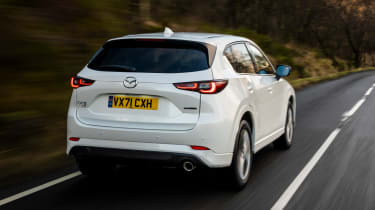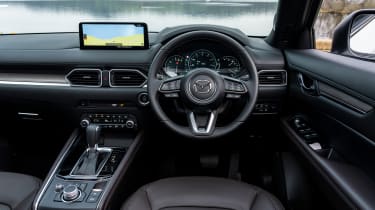New Mazda CX-5 automatic 2022 review
Mazda’s facelifted CX-5 diesel offers excellent ride quality and a premium cabin, but the automatic gearbox lets the side down a little

Verdict
We’ve already driven the 163bhp 2.0-litre petrol version of the facelifted CX-5 and, despite that engine being a little breathless, we were impressed by the car as a whole. We were especially fond of its sharp-shifting six-speed manual gearbox. Now, we’ve also driven the 2.2-litre diesel automatic and, while it’s definitely a decent choice for those regularly covering long distances, there are better options out there. Our rating reflects the automatic gearbox.
It’s almost a surprise that Mazda decided to retain a diesel option in the facelifted CX-5’s line-up – especially given the brand’s current CO2 emission-cutting electrification drive, which will bring a slew of new EVs to market by the middle of the decade.
Mazda has already swung into action. The new Mazda 2 hybrid has just hit the UK market, and the brand is already preparing for the launch of its first plug-in hybrid vehicle, the CX-60. The firm also plans to launch three new electric cars by 2025, along with a range of cleaner 48-volt mild-hybrid petrols. So why bother keeping diesel on the books at all?
Diesel is hanging around in the family SUV segment for two main reasons. The first is that, for now at least, it’s a good option for those that cover long distances regularly. The second is a matter of competition – mainstream brands such as SEAT and Skoda still offer the fuel choice in their rivals for the CX-5, so Mazda is simply keeping up with its competitors.
Used - available now
Mazda’s diesel engine is a 2.2-litre four-cylinder unit, which is available in the CX-5 in a choice of two outputs. The more expensive model has 181bhp and 445Nm of torque, but this review will focus on the entry-level option that produces 148bhp and 380Nm of torque.
Those figures sound great on paper, especially when you learn that Mazda’s diesel actually has an extra 20Nm of torque over the SEAT’s equivalent 2.0-litre diesel Ateca. But the CX-5 feels slower than its output would suggest, which we think is mostly down to the company’s six-speed automatic gearbox. However, the same diesel engine is available with Mazda’s truly excellent six-speed manual gearbox, and we’d say you’re better opting for that.
Mazda’s 2.2-litre diesel has already done its best work by around 3,000rpm, but the automatic gearbox holds onto gears for too long, which makes the engine seem less punchy than it is. The extra ratio in the Ateca automatic ‘box also more than makes up for the torque deficit – so much so, that it’s more than a second quicker from 0–62mph than the CX-5.
The diesel CX-5 is also more nose-heavy than the petrol model – and you can feel the difference in weight balance through the corners. There’s a little more understeer due to the extra weight up front, and it doesn’t change direction quite as readily.
Mazda’s claimed fuel economy figures for the 148bhp diesel CX-5 aren’t quite as good as the equivalent Ateca, either, which is also partly due to the extra cog in the SEAT’s gearbox. The CX-5 manages 46.3mpg on the combined cycle, while SEAT’s lower estimate for the Ateca’s combined cycle figure is 52.3mpg. Also, to put things into perspective, the manual version of the 148bhp diesel CX-5 has a claimed economy figure of 50.4mpg.
Mazda has fitted its facelifted CX-5 diesel with the same range of updates as the petrol model. That means there’s new dampers, softer springs and more supportive seats – all of which were intended to improve ride quality and filter out a little more road noise than the previous car. The changes have certainly made the CX-5 a more comfortable place to be, but the suspension tweaks have given the car a little more body roll as a trade-off.
The chassis updates are backed up by a handful of styling revisions, some more safety equipment and an updated trim-level range, which includes three new specifications called Newground, Sport Black and GT Sport. We drove the Sport model, though, as Mazda still expects it to be the biggest seller in the UK.
Standard equipment is impressive, with the Sport specification coming with LED headlights, 19-inch alloy wheels, front and rear parking sensors, a reversing camera and an electrically operated tailgate. The interior gets dual-zone climate control, heated front seats, a heated steering wheel and a very crisp 10.25-inch infotainment system.
And while the CX-5 is a bit more expensive than the equivalent Ateca or Qashqai, we think it’s a better finished product. Everything you touch in the cabin is covered in quality materials and the car feels like it’s been pieced together with a lot more care than its rivals. Nothing rattles (which happens more than you would expect in new cars) and all the trim is sturdy.
There’s plenty of space, too, with more than enough room in the back for six-footers to get comfortable – even with a tall driver at the wheel. The boot on the diesel model also measures 510 litres, which is six litres more than you get in the Nissan Qashqai. However, if you opt for the petrol version, this figure swells to 522 litres.
Overall, we’d say the 148bhp CX-5 diesel is a solid car, but we wouldn’t recommend pairing the engine with Mazda’s automatic gearbox if you can help it. Go for the manual, save yourself almost £2,000 in the process and keep reaping the benefits of its improved fuel economy. Your car will be much more engaging to drive, so it’s a win-win-win.
| Model: | Mazda CX-5 2.2 150PS Sport Diesel Auto |
| Price: | £34,145 |
| Engine: | 2.2-litre four-cylinder diesel |
| Power/torque: | 148bhp/380Nm |
| Transmission: | Six-speed automatic, front-wheel drive |
| 0–62mph: | 10.7 seconds |
| Top speed: | 124mph |
| Fuel economy: | 46.3mpg (WLTP) |
| CO2: | 160g/km |













